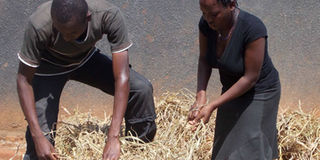Science: Getting farmers to adapt better technologies

The preservation of fodder and better agronomic practices for crops were some of the activities that the researchers and farmers cooperated on. Photo by Michael J. Ssali.
A team of researchers and animal breeders from the National Livestock Resources Research Institute (NaLIRRI) spent two days, December 12 and 13, visiting farmers in Masaka and Kalungu Districts.
They were monitoring the extent to which farmers were taking up technologies and innovations that the researchers had rolled out to the farmers’ groups in 2009 and 2011 by working with them on their farms.
In the recent years, researchers have increasingly worked with smallholder farmers in different parts of Uganda to promote and sustain crop and livestock production in the wake of challenges posed by climate change.
This is part of a wider project supported with funding from the Association for Strengthening Agricultural Research in Eastern and Central Africa (ASARECA).
The technologies included value addition, food preservation, rainwater harvesting, irrigation, fodder production and conservation, feed formulation, all-year-round vegetable production, labour-saving technologies, soil sustainability, environment protection, and enterprise diversification.
Involved farmers
The rationale behind researchers working with farmers was to demystify research and research findings which most farmers may regard as unrelated to their daily farming activities.
Peter Daki of the Akamira Eyiye Farmers Group in Kitenga Village, Mukungwe Sub-county, Masaka District, where a forage scientist, Dr Jolly Kabirizi, spent several months, said, “We have also been involved in the demonstration activities and we know what works well and what does not.”
In their gardens, for example, they have vegetable plots on which manure from livestock like poultry litter and cow dung was applied, and irrigation used during the dry season. The farmers were all able to point at the vegetable garden that had the best looking crop.
They knew what had been done, how it had been done and what worked best, what manure was most efficient and how much water was applied for irrigation to come up with the most successful results.
Share experiences
The farmers learned to make hay and silage (forage conservation), which they fed to the cows and noticed that they could sufficiently use the preserved fodder to feed their cattle during the dry season. They planted drought-resistant and nutrient-rich fodder grasses such as Lablab, Bracharia, and Calliandra and noticed increased milk production (estimated to be 20 per cent).
They even learnt that fodder has to be attended to, nurtured, and protected from disease just like food crops. They were introduced to low-cost rainwater harvesting technologies such as rooftop and surface runoff water collection in ponds lined with tarpaulin. With the use of a locally manufactured treadle pump and plastic tubes, the farmers are able to pump water to their gardens and their animals.
They discovered they could use drip irrigation to produce vegetables throughout the year. They were introduced to simple solar-drying technologies to preserve pineapples, sweet bananas, and other fruits as well as vegetables.
The Masaka and Kalungu trip was also an opportunity for the scientists to share the farmers’ successes and challenges. Josephine Kizza, the Executive Director, St Jude Family Projects, was asked by the researchers how she managed to retain many of her employees. She answered: “If you want to succeed in any business, please respect and listen to your staff and motivate those who excel.”
Take up faster
They also got information on integrating family members into a farming business from Peter Lubyayi, a livestock farmer at Nyendo-Kasana in Mukungwe Sub-county. He told them about some challenges, for instance, noticing that a cow is on heat and calling a veterinary officer to do artificial insemination and he delays or even fails to turn up at all. “He might delay over such excuses as being present at his son’s baptismal function but because he needs the money, anyway, he may come very late on the same day or the following morning when perhaps the cow’s time to conceive has passed or when the semen is already dead and useless.”
When the farmers are involved, they take up the technology faster and spread it to other farmers than when agricultural extension personnel come and tell them how to apply it.
Farmers learn more from one another through seeing a successful innovation. Their practical involvement in the trials and demonstrations is now viewed as perhaps the best approach to enable uptake of research results and new technologies.




